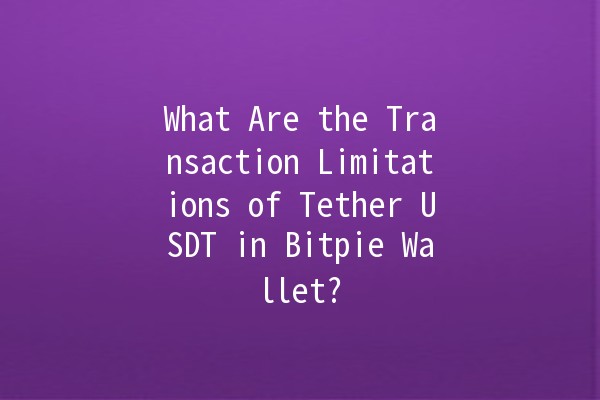
In the everevolving world of cryptocurrency, having the right tools at your disposal is crucial for success. One such tool is the Bitpie wallet, which offers users a convenient way to manage their cryptocurrency holdings, particularly Tether (USDT). However, understanding the transaction limitations associated with USDT in Bitpie can significantly enhance your experience and help you navigate potential challenges.
Understanding Bitpie Wallet and USDT
Bitpie Wallet is a popular multicrypto wallet known for its userfriendly interface and robust security features. It supports various cryptocurrencies, including Bitcoin, Ethereum, and USDT. Tether is one of the most widely used stablecoins, pegged to the US dollar, making it a popular choice for traders looking to mitigate volatility.
Transaction Limitations of USDT in Bitpie Wallet
One of the primary limitations when dealing with USDT in Bitpie is the daily withdrawal limit. Many wallets impose a cap on how much cryptocurrency you can withdraw within 24 hours to enhance security.

Practical Example: For instance, if your daily withdrawal limit is set at 1,000 USDT, you will not be able to withdraw more than that amount until the next 24hour cycle begins. This can be challenging for traders who need to move large amounts quickly, especially during market fluctuations.
When conducting transactions with USDT, users must also be aware of network fees. These fees can vary significantly based on the current network conditions and the specific blockchain being used (like Ethereum or Tron).
Practical Example: If you're transacting on the Ethereum network, and the gas fees spike due to high demand, you could end up spending more on fees than anticipated. This can affect your overall trading strategy, especially if you're just trying to transfer funds to another exchange for arbitrage opportunities.
The time it takes for a USDT transaction to be processed can also be a limitation. While some transactions may be completed within minutes, others could take hours, depending on network congestion and the specific blockchain protocol.
Practical Example: If you're trading and you need to move your USDT quickly, the processing time could hinder your ability to capitalize on market conditions. For instance, if an urgent trading opportunity comes up, a delayed transaction could mean missing out on potential profits.
Another consideration is the AntiMoney Laundering (AML) and Know Your Customer (KYC) regulations that Bitpie must adhere to. Users may encounter limitations in their transactions based on their compliance status.
Practical Example: If you haven’t completed your KYC verification, you might be limited to small transactions or may not be able to withdraw funds at all. This can hinder your ability to trade effectively, especially if rapid trading is necessary for your strategy.
Certain regions might have additional restrictions affecting USDT transactions. This can include limitations imposed by local regulations that vary by country.
Practical Example: If you are located in a region with strict cryptocurrency regulations, you may face limitations on how much USDT you can transfer or hold in your Bitpie wallet. This can affect international traders who might need to manage their assets across different jurisdictions.
Five Productivity Enhancement Techniques for Managing USDT Transactions
Understanding these limitations is only part of the journey. Here are five techniques to enhance your productivity while managing USDT transactions in Bitpie Wallet:
Explanation: Utilize price alert features available on Bitpie or thirdparty apps to stay informed about price movements.
Application: For example, setting an alert for when USDT drops below a specific price can help you make timely purchase decisions.
Explanation: Keep abreast of your daily withdrawal limits and any changes in Bitpie’s policies.
Application: Schedule a regular checkin, perhaps weekly, to ensure you’re aware of your limits and adjust your trading strategies accordingly.
Explanation: Use USDT on different blockchains (like Tron or Ethereum) to save on network fees and optimize transaction times.
Application: Analyze current network conditions and choose the most costeffective chain for transfers to minimize fees and delays.
Explanation: Complete your KYC process as early as possible to avoid transaction limitations.
Application: Gather and submit required documentation promptly so you can trade without restrictions when market conditions change.
Explanation: Participate in online forums and communities related to Bitpie and USDT to learn from others' experiences.
Application: Join platforms like Reddit or Telegram groups focused on cryptocurrency trading to gain insights about overcoming common limitations.
Common Questions About USDT Transactions in Bitpie Wallet
If you hit your withdrawal limit, consider waiting for the 24hour period to reset, or review your past transactions to ensure you're utilizing your available limits effectively.
Network fees are essential to consider as they can eat into your profits, especially during peak times. Always check the current gas fees before making significant transfers.
If your transaction is delayed, check the status on the blockchain explorer relevant to the network you're using. If it's stuck, you may need to wait until the network congestion eases.
Typically, there are no specific holding limits within Bitpie, but regulatory compliance and your regional laws might impose restrictions.
To lower transaction fees, consider executing transfers during offpeak hours when the network is less congested or switch to a blockchain with lower fees.
Daily withdrawal limits are generally determined by Bitpie’s policies. However, you can check your settings or potentially upgrade your account for higher withdrawal allowances if available.
By understanding the limitations of USDT transactions in the Bitpie wallet and employing these tips and techniques, you can better navigate the cryptocurrency landscape and make informed trading decisions. Remember, staying informed helps you capitalize on opportunities and manage risks effectively in this dynamic market.

